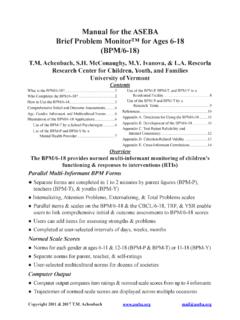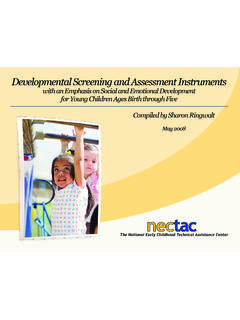Transcription of ASEBA-PC Procedures Manual
1 ASEBA-PC Procedures Manual (For Updated Procedures , go to ) Version: October 7, 2016 1 Table of Contents Signing In to ASEBA-PC .. 3 User Menu (System Admin) Functions .. 5 Users Management (Administrative Users only) .. 5 Viewing, Editing, or Adding a User .. 6 Auditing Tools (Administrative Users only) .. 11 Themes .. 14 License Agreement (Administrative Users only) .. 14 Change Password .. 15 Logout .. 16 Adding and Making Changes to a Directory .. 17 Add Directory/Subdirectory .. 17 Add Assessed Person (to a Directory) .. 18 Edit Directory/Subdirectory .. 20 Delete Directory/Subdirectory .. 21 Move Directory/or Subdirectory .. 22 Refresh Directories .. 22 Downloading/Exporting Data .. 22 Adding, Editing, Deleting, Viewing, and Merging Assessed Persons.
2 23 Add Assessed Person .. 23 Edit Assessed Person .. 25 Delete Assessed Person .. 26 View Selected Assessed Person .. 27 Move Assessed Persons .. 29 Refresh Assessed Persons .. 30 Informants: Adding, Editing, Deleting, Merging Informants, and .. 31 Adding a Form for a Selected Informant .. 31 Add Informant .. 31 Edit Informant .. 34 Delete Informant .. 34 Add a Form for a Selected Informant .. 35 Refresh Informants .. 36 Importing Data .. 37 Downloading/Exporting and Opening Data Files .. 42 2 Form Functions .. 46 Add a Form .. 46 Details/Comments for an entered form .. 53 Edit a Completed Form .. 58 Key Entry of a Completed Form .. 59 Score/View Report .. 61 Delete a Form .. 62 Go to an Assessed Person .. 63 Find an Informant for a particular form.
3 64 Refresh Forms .. 65 Scoring, Export, and/or Print Report .. 67 General Instructions/Notes Regarding Reports .. 67 Score/View Report .. 68 Score/View Cross-Informant Report .. 69 View MFAM Multi-Informant Report .. 72 3 ASEBA-PC Procedures Signing In to ASEBA-PC The Sign In function allows users to gain access to the ASEBA-PC application. 1. Open ASEBA-PC . 2. The Sign In screen below will display: 3. Enter your User Name, Password, and Account (If this is your first time signing in to ASEBA-PC , enter the credentials provided to you). 4. Click Sign In. 5. When signing in for the first time, the following screen will open, displaying fields for User Name, Current Password, Account, Password, Password Confirmation, as well as a link to the End User License Agreement (EULA): 4 6.
4 Enter User Name and Current Password again as provided to you. 7. Enter a NEW Password that is at least 10 characters. 8. Confirm the new password by re-typing it in the Confirm New Password box (If passwords do not agree, user will receive an error message stating that New password and password confirmation are not equal ). 9. Click on the link (underlined in blue) to read the End User License Agreement (EULA). 10. When you are finished reading the End User License Agreement, click the X box in the upper right corner to close it. 11. If you are in agreement with the contents of the End User License Agreement, click the box to the right of the statement, I have read, and I agree with the EULA . (If this box is not checked, a message will appear, stating, User must agree to EULA , and screen will not advance) 12.
5 Click Change. 13. The following screen will display: 14. Sign In with the updated credentials (as per steps 3 and 4 above). 15. Program will open to Directories. 5 ASEBA-PC Procedures User Menu (System Admin) Functions The User Menu (System Admin) functions in ASEBA-PC are used to set up or make changes to certain program features. Administrative Users have access to all features, whereas Regular Users only have access to Themes, Change Password, and Log Out. User Menu (System Admin) functions currently available in ASEBA-PC include the following: 1. Users Management* 2. Auditing Tools* 3. Themes 4. License Agreement* 5. Change Password 6. Log Out *These features are only available to Administrative Users _____ Users Management (Administrative Users only) Use this function to manage program access (users, roles and access, e-mail addresses, and password features).
6 1. Sign in to ASEBA-PC . 2. Navigation: My Account (from the tab on top)> Users Management 3. The screen will open, displaying a list of current users on the left (or will be blank if none have been entered), and New, Refresh, and Close tabs at the top of the screen: 6 Viewing, Editing, or Adding a User: a. Add a new user: select New. A screen will open up, displaying boxes to enter User Name, Password, Password Confirmation, Roles, First Name, Last Name, and Email. User Name: Enter a User Name in the box. Spaces or any other special characters are not allowed, with the exception of dashes (-) which can be used in any position other than the first or last. Password: Enter a password that is at least 10 characters in length and contains at least 3 of the following characters: one upper case letter, one lower case letter, one digit, and one other character.
7 Password Confirmation: Re-type the password you entered. If passwords do not agree, user will receive an error message stating New password and password confirmation do not match . Roles: Click on the down arrow to display a pull-down list and select Administrator or Regular User. First Name: Enter user s first name. Last Name: Enter user s last name. Email: Enter user s e-mail address. Click Save or Cancel (to close screen without saving). b. View or edit a current user: Select/highlight the name on the list. The screen will open up, displaying previously-entered information for User Name, Role, First Name, Last Name, Email, Account Disabled or Not, and Whether a Password Reset is required. The buttons along the 7 bottom of the screen allow user access to Set Password, Set Role, Request Password Reset, Enable/Disable, and Edit.
8 C. Set Password: Clicking the Set Password button will allow you to set/change a password. Enter a password that is at least 10 characters in length and contains at least 3 of the following characters: one upper case letter, one lower case letter, one digit, and one other character. Confirm the password by re-typing it in the Password Confirmation box (If passwords do not agree, user will receive an error message stating that New password and password confirmation do not match ). Select Save (if you ve made a change) or Cancel (to keep existing password). 8 d. Set Role: Click on the down arrow to display a pull-down list and select Administrator or Regular User. Select Save (if you ve made a change) or Cancel (to keep existing role) e.
9 Request Password Reset: Check box if this user needs to reset their password. Select Submit (if you ve made a change) or Cancel (to keep existing password). f. Enable/Disable Account: Check box to disable account or leave unchecked to indicate account is enabled. Select Change (if you ve made a change) or Cancel (to keep existing setting). 9 10 g. Edit User: Selecting Edit will allow user to make changes to the user s first name, last name, and e-mail address. Select Save (if you ve made a change) or Cancel (to keep existing user information). 11 Auditing Tools (Administrative Users only) This function generates user activity and transaction logs which can be saved and/or reviewed. a. Sign in to ASEBA-PC . b. Navigation: My Account (from tab on top) > Auditing Tools c.
10 The screen will open, displaying a list of options for generating activity and transaction logs. d. In the Username box, click the down arrow to access the pull-down menu and select the person for whom you want to create an activity or transaction log. 12 e. In the From box, select the start date from which you wish to begin the log by either using the calendar feature (select icon on the right and follow the format 4-digit year- 2 digit month-2 digit day as in 2000-12-30) or hand-key in the date using the same format. f. In the To box, select the log end date by either using the calendar feature (select icon on the right and follow the format 4-digit year-2 digit month-2 digit day as in 2000-12-30) or hand-key in the date using the same format.




